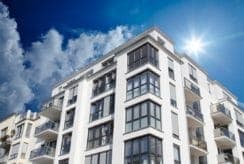Several major changes mark this second step:
- neighborhoods selected for their urban problems within a “Policy priority area of the City” narrowed and determined by a single criterion (territorial concentration of poverty of the inhabitants);
- greater involvement of residents in the development of projects;
- developing and implementing a prefiguration protocol before the signing of the agreement itself;
- linking this agreement with the city contract and establishing an integrated territorial project;
- governance of projects undertaken by the EPCI (public establishments for cooperation between local authorities), etc.
However, the most striking development for these projects and especially for the project owners who signed the agreement should be the decline in funding from ANRU (French national urban renewal agency): The equivalent of €5 billion[1] in subsidies[2] is currently expected, compared with €12.5 billion in subsidies for the first PNRU. The budget situation is already tense for the local authorities (the State is reducing its funding there also). As such, whilst the need to continue the program and the motivation of local players is still present, the financial equation is more difficult to solve.
2016 will be characterized by the implementation of prefiguration protocols throughout France: urban, social, technical, environmental, etc. studies must provide information to clarify the role of the neighborhood in the urban area, an urban and social plan, a timetable, the approach to governance, and a fundable budget.
It is therefore likely that the ANRU funding will focus on operations:
1- where the situation is deemed to be the highest priority – knowing that among the 200 neighborhoods, it will be difficult to put them into a hierarchy;
2- where the agreements have been reached most quickly and in keeping with the new urban planning methodology developed by the ANRU; and
3- especially where the project leaders have managed to work on the economic balance of their operation, by mobilizing public funding reasonably.
What solutions do project owners have to work on the balance of operations ?
Without aiming to be exhaustive or a quick fix, here are some ideas for working on the balance of operations:
Changing the rules of the game
The objective is to think of the ANRU operation as an overall action to properly calibrate the planned operations, without going through a development operation (mixed development zone, concession, partnership urban project, etc.) that would be relatively burdensome to arrange. However, the development assessment technique may seem interesting to work on a balance between the required level of quality, the invested amounts, and the return on investment expected by the project owners (whether in terms of new attractiveness – and indirectly taxes and rents received – or ease of maintenance).
Such thinking can lead project leaders and project owners to wonder about the scope of action or even consider the operation on several coordinated sites. That would make relocations and rebuilding supply easier and respond operationally to the need to define the role of the neighborhood in the urban area.
Increasing the number of players and counting on partnership
In the same way, working on public/private arrangements is another approach. There are several virtues to integrating and identifying private operators in housing, commerce, etc. from the beginning of the operation in order to help put the ANRU operation in place:
+ Verifying the feasibility of the operation before its actual launch, particularly with regard to the amount of land charges;
+ Building special relationships with one or more developers and engaging in discussions on action at the city or urban area level;
+ Not leaving the housing authority (AFL) alone in a “passive” strategy of diversifying the supply but building an integrated strategy shared with players in housing: community housing departments, social landlords, ALF, and private developers.
The work on a suitable housing product and innovation in terms of modularity and arrangement with more functional and/or social diversity in a building or block (division permits, property sales before completion, reversed property sales before completion, etc.) can emerge from a public/private partnership set up as early as possible in the project.
Enhancing the value of the cards dealt
Enhancing the value of an existing asset base is at the heart of the dynamics of urban renewal. The proposal here involves merging two approaches that were at times difficult to consolidate during the first generation of the PNRU: developing a territory (objective generally pursued by the local authority) and developing an asset base (objective generally pursued by landlords or owners).
This particularly involves work on the relationship between the Strategic Asset Plan (PSP) and the ANRU agreement. The revision of strategic asset plans, mandatory for all landlords, is prompting them to diagnose all of their assets in terms of socio-residential operation, social occupation, technical condition (structure quality, adaptation to standards, etc.), attractiveness in the broad sense, contribution of each residence to the organization’s cash flow, etc. This diagnosis leads to the definition of strategic guidelines and an action plan in the landlord’s budget. The Strategic Action Plan therefore provides essential perspective to local partners in housing policy to set up interventions that meet the asset-related issues of landlords, who are often the central project owners of the agreements.
Enhancing the value of the existing asset base also involves working on the potential of land densification, particularly land owned by low-income housing (HLM) organizations, in order to generate further financial flexibility and new investment capabilities. For example, this involves producing an analysis of the potential for adding height to existing buildings but especially adding value to neglected properties and “urban voids.” The redevelopment of under-utilized plots (parking structures in particular) or the demolition/reconstruction of degraded residences can also be considered. This analysis can also feed into an urban renewal strategy.
Although the urban and social dimension of urban renewal projects must remain the focus of the strategy of future agreements of the NPNRU, the economic dimension will also be vital in a budget context that is much more constrained than previously. The regulations have also become more complex (asbestos, disabilities, energy, etc.) and are weighing on project owners. These real constraints are also opportunities to achieve balanced, truly partnership-based projects.
Article co-written by Rose Megard, Senior consultant, and Violaine Victor, Senior manager
[1] 93% funded by Action Logement.
[2] €4.2 billion in subsidies and equivalent of €0.8 billion in subsidies corresponding to the differential in rates on subsidized loans.

